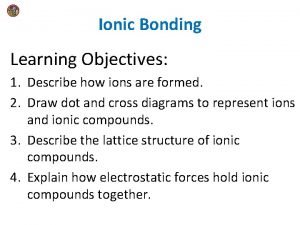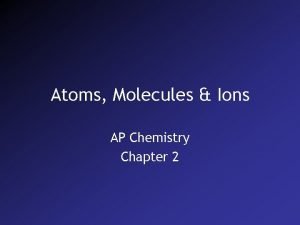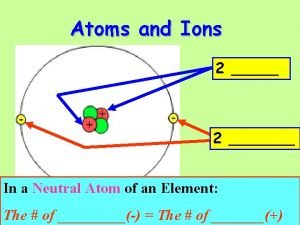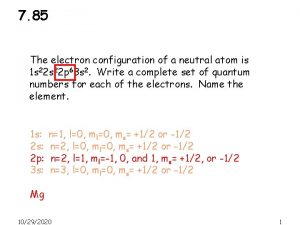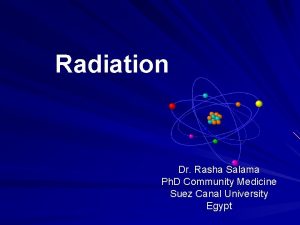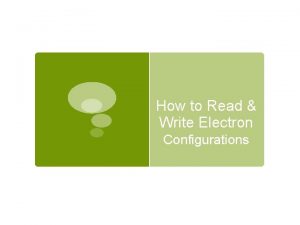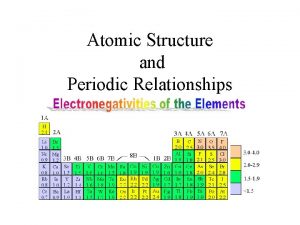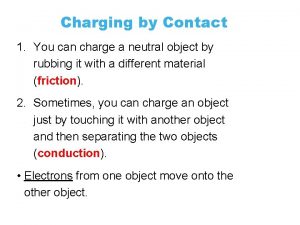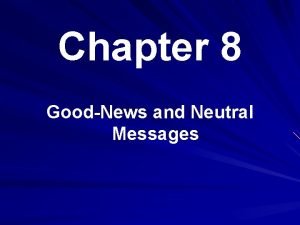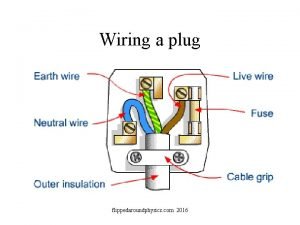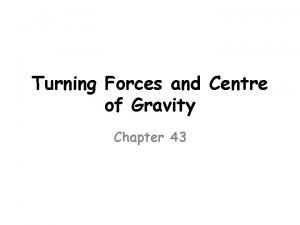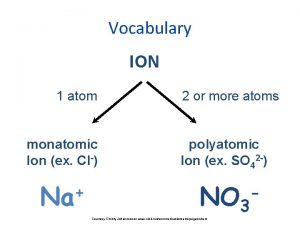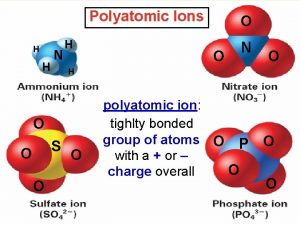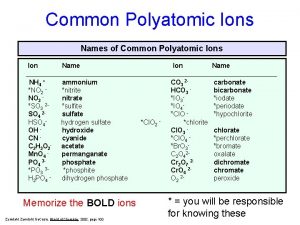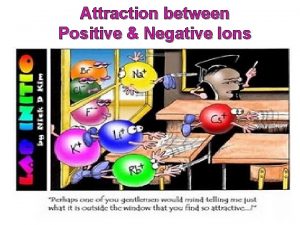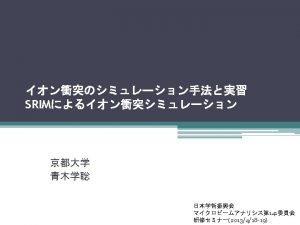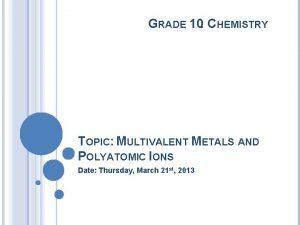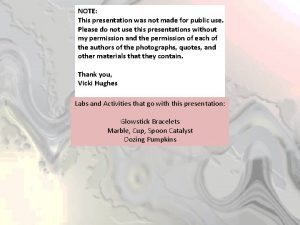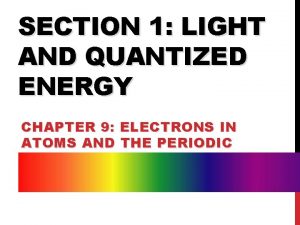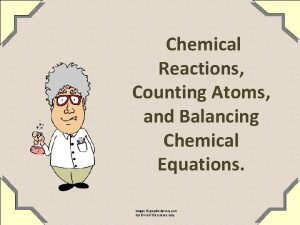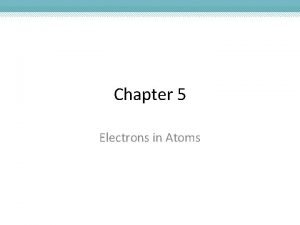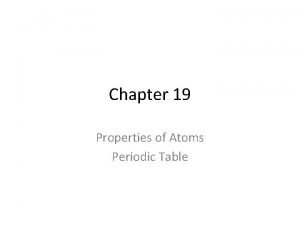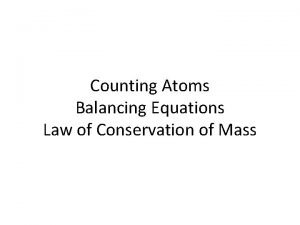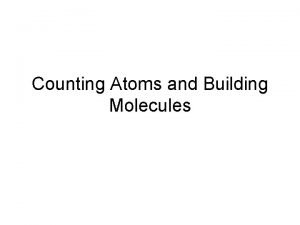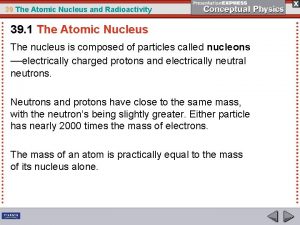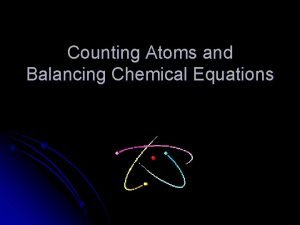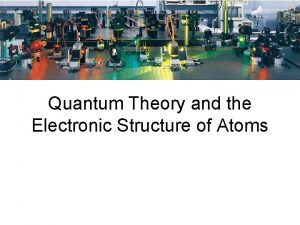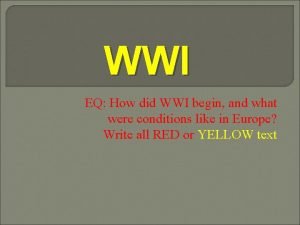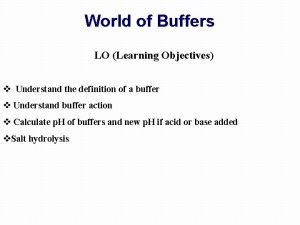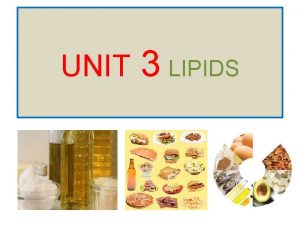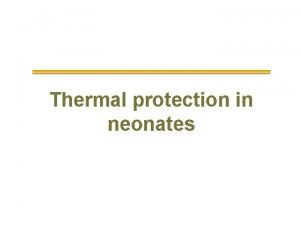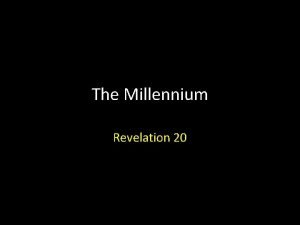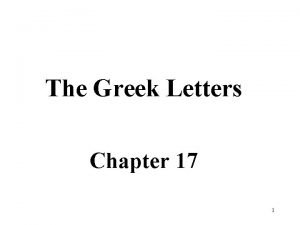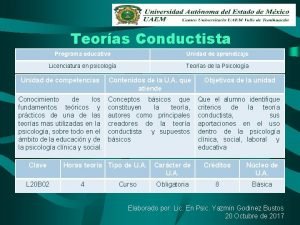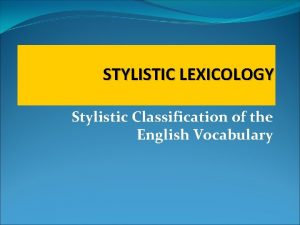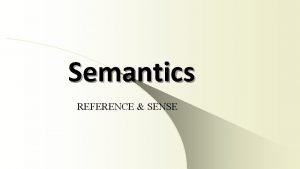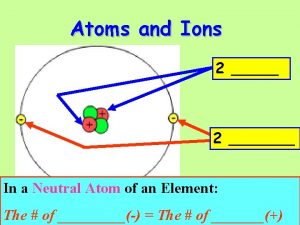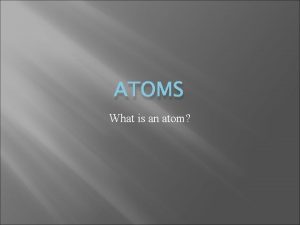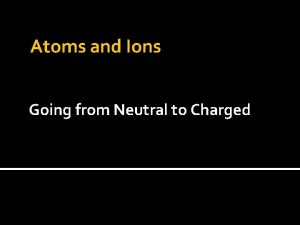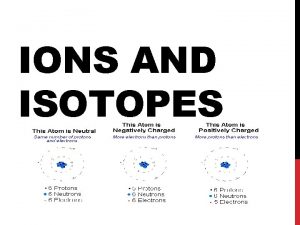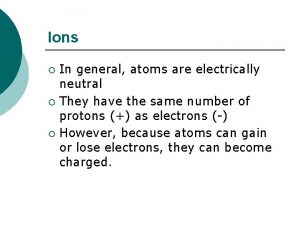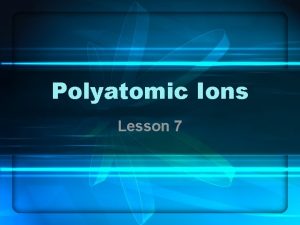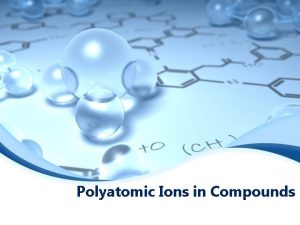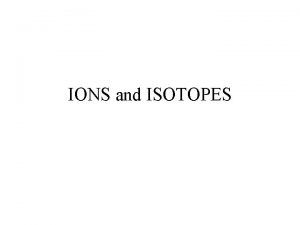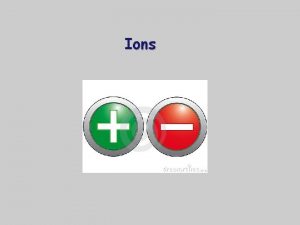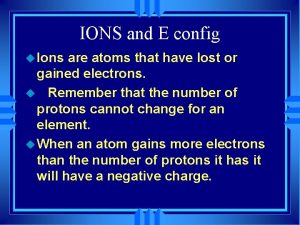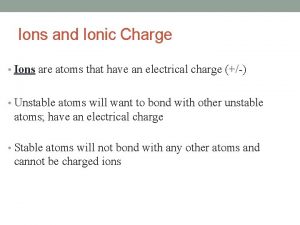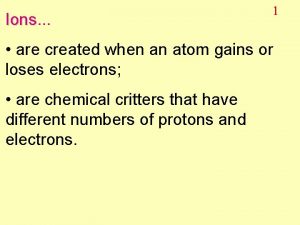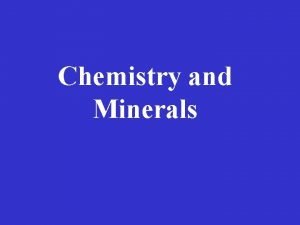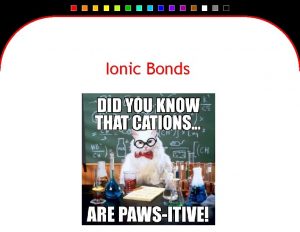Atoms and Ions 2 In a Neutral Atom
































































- Slides: 64

Atoms and Ions 2 _______ In a Neutral Atom of an Element: The # of _____(-) = The # of _______(+)

This represents an ____ of the element ____ ( __P’s & __ e-’s)

We have now taken one electron away from Lithium!

It still has _ Protons, but now only _ electrons! (Neutrons haven’t changed)

This is no longer called “A Lithium Atom”. It is now called a Lithium ___.

+ + + - Because Protons are Positive (+) and Electrons are Negative (-), this Lithium Ion has 3+’s and 2 –’s.

+ + + - Because Protons are Positive (+) and Electrons are Negative (-), this Lithium Ion has 3+’s and 2 –’s. It has a “Net Charge” of __. ( +3 and – 2 = __)

An Ion is an atom in which # of ________ (Neutrons don’t matter here) An Ion can also be defined as an atom with a _______ (Protons or Electrons are “left over”)

+ A Lithium ___ is shown as having a net +1 charge.

+ + Li The symbol for a Lithium Ion is ___

(Take out your Periodic Table!) A Neutral Sodium (Na) Atom has ____ Protons(+) and ___ Electrons(-)

(Take out your Periodic Table!) A Neutral Sodium (Na) Atom has __ Protons(+) and __ Electrons(-) Na Has __ Protons(+) in the Nucleus Has __ Electrons(-) around the outside.

A Neutral Sodium atom has a net charge of _____ Na Has __ Protons(+) in the Nucleus Has __ Electrons(-) around the outside.

OKAY. Let’s REMOVE an electron from the Sodium Atom!

It still has __ Protons(+), but now it only has __ Electrons(-) (There is ONE P(+) left over! ) Na Has __ Protons(+) in the Nucleus Has __ Electrons(-) around the outside.

It still has __ Protons(+), but now it only has __ Electrons(-) (There is ONE P(+) left over! ) The NET CHARGE is __ Na Has __ Protons(+) in the Nucleus Has __ Electrons(-) around the outside.

It still has __ Protons(+), but now it only has __ Electrons(-)(There is ONE P(+) left over! )The NET CHARGE is __ A Sodium Ion has the symbol ___ Na Has __ Protons(+) in the Nucleus Has __ Electrons(-) around the outside.

(Take out your Periodic Table!) A Neutral Magnesium (Mg) Atom has ____ Protons(+) and ___ Electrons(-)

(Take out your Periodic Table!) A Neutral Magnesium (Mg) Atom has __ Protons(+) and __ Electrons(-) Mg Has __ Protons(+) in the Nucleus Has __ Electrons(-) around the outside.

Magnesium tends to easily lose 2 electrons!

It now has __ Protons(+) and __ Electrons(-) Mg Has __ Protons(+) in the Nucleus Has __ Electrons(-) around the outside.

The NET CHARGE on this Magnesium ion is now _______ And the symbol for a Magnesium ion is: _____

So an Mg 2+ ion has ___Protons(+) and ___Electrons(-)

So an Mg 2+ ion has __ Protons(+) and __ Electrons(-) The ATOMIC NUMBER on the Periodic Table If the NET CHARGE is 2+, it means it has 2 LESS Electrons than Protons! (Protons don’t change, only Electrons!)

An Al 3+ ion has ___Protons(+) and ___Electrons(-)

So an Al 3+ ion has __ Protons(+) and __ Electrons(-) The ATOMIC NUMBER on the Periodic Table If the NET CHARGE is 3+, it means it has 3 LESS Electrons than Protons! (Protons don’t change, only Electrons!)

Electrons can be ADDED to Neutral Atoms to make IONS. If an Ion has MORE Electrons(-) than Protons(+), the NET CHARGE on that ion is (positive/negative) ______

(Take out your Periodic Table!) A Neutral Fluorine (F) Atom has ____ Protons(+) and ___ Electrons(-)

A Neutral Fluorine (F) Atom has __ Protons(+) and ___ Electrons(-) F Has __ Protons(+) in the Nucleus Has __ Electrons(-) around the outside.

So a Neutral Fluorine Atom (9 P’s and 9 e-’s) has a NET CHARGE of _______

If we add ONE Electron to a Neutral Fluorine Atom, it will now have ___P’s(+) and ___e-’s(-) and the NET CHARGE on the ion will be ___. The symbol for a Fluoride Ion is ______

The ion O 2 - has ___Protons and ___Electrons.

The ion O 2 - has __ Protons and __ Electrons. This is the ATOMIC NUMBER of Oxygen A NET CHARGE of 2 - means it has 2 MORE Electrons(-) than Protons(+)

The ion As 3 - has ___Protons and ___Electrons.

On the top right of each element on the Periodic Table is the ________ of the most common ion of each element.

The top left on the Periodic Table shows the ______ NUMBER or # of ____.

In a Neutral Atom (Atom) of an Element, the # of e-’s = # of P’s So a (neutral) potassium atom has ___ protons and ___ electrons

The NET CHARGE on a potassium ION is + (means +1) This means that there is ONE LESS electron than protons So a potassium ION has ___ protons and ___ electrons

The NET CHARGE on a Scandium ION is 3+ (means +3) This means that there is ONE are THREE LESS electron than protons electrons than protons So a Scandium ION has __ protons and __ electrons

Iron (Fe) can form TWO DIFFERENT ions: One with a net charge of 3+

Iron (Fe) can form TWO DIFFERENT ions: One with a net charge of 3+ This ion Fe 3+ would have __ Protons and __ Electrons

Iron (Fe) can form TWO DIFFERENT ions: The other ion would have a net charge of 2+( Iron(II) )

Iron (Fe) can form TWO DIFFERENT ions: The other ion would have a net charge of 2+( Iron(II) ) This ion Fe 2+ would have __ Protons and __ Electrons

Negative Ions (Ions of NON-METALS) change the ending of their names to IDE, IDE So Cl- is called a CHLORIDE ion.

The NET CHARGE on a Chloride ION is - (means -1) This means that there is ONE MORE LESS electron than protons So a chloride ION (Cl-) has ___ protons and ___ electrons

The NET CHARGE on a Sulphide ION is 2 - (means -2) Thismeansthatthereis TWO is ONE MORE LESS electrons electron thanprotons So a Sulphide ION (S 2 -) has __ protons and __ electrons

A Sulphur atom has __ Protons and __ Electrons.

Remember, this means the NET CHARGE on an ION, ION not on an ATOM

Use your Periodic Table to find the # of Protons and # of Electrons in each of the following: Symbol A Barium ion A Phosphide ion A Nitrogen atom A Nitrogen ion A Gallium atom A Gallium ion # of Protons # of Electrons

Remember that given Nuclear Notation, we can find the number of Protons and Neutrons:

To find P’s and N’s from Nuclear Notation Mass # = P + N To find # of Neutrons, put Atomic Number Here: Subtract to get # of Neutrons 41 Ca Calcium’s atomic Number = ____ So it has __ Protons So it has __ Neutrons

We can also find the Number of Electrons!

If we are given this: 41 Ca There is NO number on the top right, so this must be a _______ ATOM and the NET CHARGE = ___

If we are given this: 41 Ca There is NO number on the top right, so this must be a NEUTRAL ATOM and the NET CHARGE = 0 In a neutral atom #of _’s = # of _’s

If we are given this: 41 Ca There is NO number on the top right, so this must be a NEUTRAL ATOM and the NET CHARGE = 0 In a neutral atom #of P’s = # of e-’s So this atom has: __ protons and __ electrons

To Summarize: 41 Ca Has: __ Protons (Atomic Number) __ Neutrons (41 -20 = 21) and __ Electrons (e-’s = P’s)

Now try this one: 41 Ca 2+ Has __ Protons __ Neutrons __ Electrons

Now try this one: 37 Br. Has __ Protons __ Neutrons __ Electrons

Now try this one: 238 U 4+ Has __ Protons __ Neutrons __ Electrons

Now try this one: 33 P 3 Has __ Protons __ Neutrons __ Electrons

The isotope: 76 As 3 - has __ protons __ neutrons __ electrons

The isotope: 201 Au+ has __ protons ___ neutrons __ electrons

An isotope has 46 protons, 58 neutrons and 42 electrons. Write the nuclear notation:

An isotope has 52 protons, 79 neutrons and 54 electrons. Write the nuclear notation:
 What do the roman numerals in a cation's name indicate?
What do the roman numerals in a cation's name indicate? Atoms molecules and ions
Atoms molecules and ions Atoms molecules and ions
Atoms molecules and ions Atoms molecules and ions
Atoms molecules and ions Atoms molecules and ions
Atoms molecules and ions Atoms ions and molecules
Atoms ions and molecules Atoms ions and molecules
Atoms ions and molecules Collision theory states that
Collision theory states that Chapter 2 atoms molecules and ions
Chapter 2 atoms molecules and ions More protons than electrons
More protons than electrons Atoms or ions are considered isoelectronic if
Atoms or ions are considered isoelectronic if At stp which substance is the best conductor of electricity
At stp which substance is the best conductor of electricity Quantum mechanical model
Quantum mechanical model Electrons in atoms section 2 quantum theory and the atom
Electrons in atoms section 2 quantum theory and the atom Neutral atom qubits
Neutral atom qubits How many electrons are in neutral 41ca atom
How many electrons are in neutral 41ca atom Which neutral atom is isoelectronic with o+
Which neutral atom is isoelectronic with o+ Rasha salama
Rasha salama How to read electron configuration
How to read electron configuration A neutral atom of aluminum 27 contains
A neutral atom of aluminum 27 contains The structure of the atom section 2 defining the atom
The structure of the atom section 2 defining the atom Kelemahan teori dalton
Kelemahan teori dalton Gender-neutral housing pros and cons
Gender-neutral housing pros and cons Charging by conduction
Charging by conduction What is neutral message
What is neutral message Ethics is a personal and individual affair
Ethics is a personal and individual affair Ground live neutral
Ground live neutral Given chapter 43
Given chapter 43 Live neutral and earth wires
Live neutral and earth wires Polyatomic vs monatomic ions
Polyatomic vs monatomic ions What is a polyatomic ion
What is a polyatomic ion Monatomic and polyatomic ions
Monatomic and polyatomic ions Names of common polyatomic ions
Names of common polyatomic ions Electron dot structure of magnesium fluoride
Electron dot structure of magnesium fluoride Srim the stopping and range of ions in matter
Srim the stopping and range of ions in matter Multivalent metals and polyatomic ions
Multivalent metals and polyatomic ions Freezing point chapter 13
Freezing point chapter 13 Chemical formulas list
Chemical formulas list Ions and ionic bonding cornell doodle notes
Ions and ionic bonding cornell doodle notes Relationship between atoms and molecules
Relationship between atoms and molecules Electrons in atoms section 1 light and quantized energy
Electrons in atoms section 1 light and quantized energy Substance
Substance Balance the equation
Balance the equation Electrons in atoms section 1 light and quantized energy
Electrons in atoms section 1 light and quantized energy Properties of atoms and the periodic table
Properties of atoms and the periodic table Mit center for bits and atoms
Mit center for bits and atoms Adding atoms
Adding atoms How can you count atoms and molecules
How can you count atoms and molecules Section 1 atoms elements and compounds
Section 1 atoms elements and compounds Chapter 6 section 1 atoms elements and compounds
Chapter 6 section 1 atoms elements and compounds Atoms and radioactivity
Atoms and radioactivity Counting atoms and balancing equations worksheet
Counting atoms and balancing equations worksheet Atoms and their isotopes pogil
Atoms and their isotopes pogil Chapter 6 section 1 atoms elements and compounds
Chapter 6 section 1 atoms elements and compounds Quantum theory and the electronic structure of atoms
Quantum theory and the electronic structure of atoms Where did wwi begin
Where did wwi begin Is kno3 acidic basic or neutral
Is kno3 acidic basic or neutral Fats and lipids
Fats and lipids Thermoneutral environment for neonates
Thermoneutral environment for neonates There is no neutral ground in the universe
There is no neutral ground in the universe Vega greek letter
Vega greek letter Condicionamiento clasico y operante
Condicionamiento clasico y operante Barbarisms and foreignisms
Barbarisms and foreignisms Affective meaning in semantics
Affective meaning in semantics Stuck in neutral summary
Stuck in neutral summary









